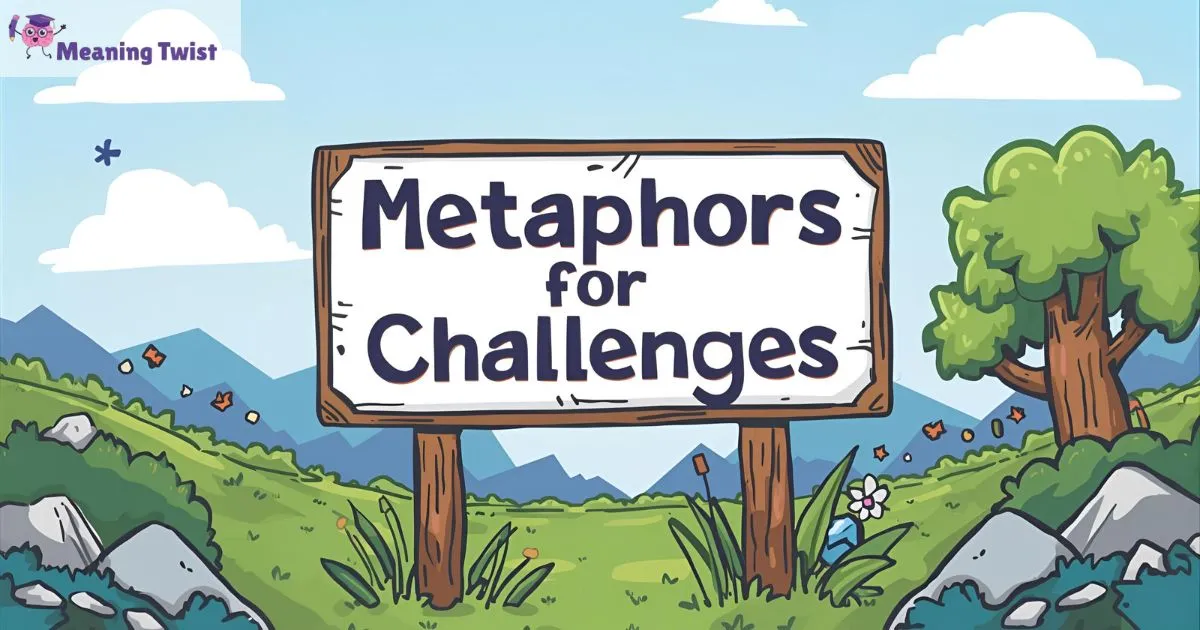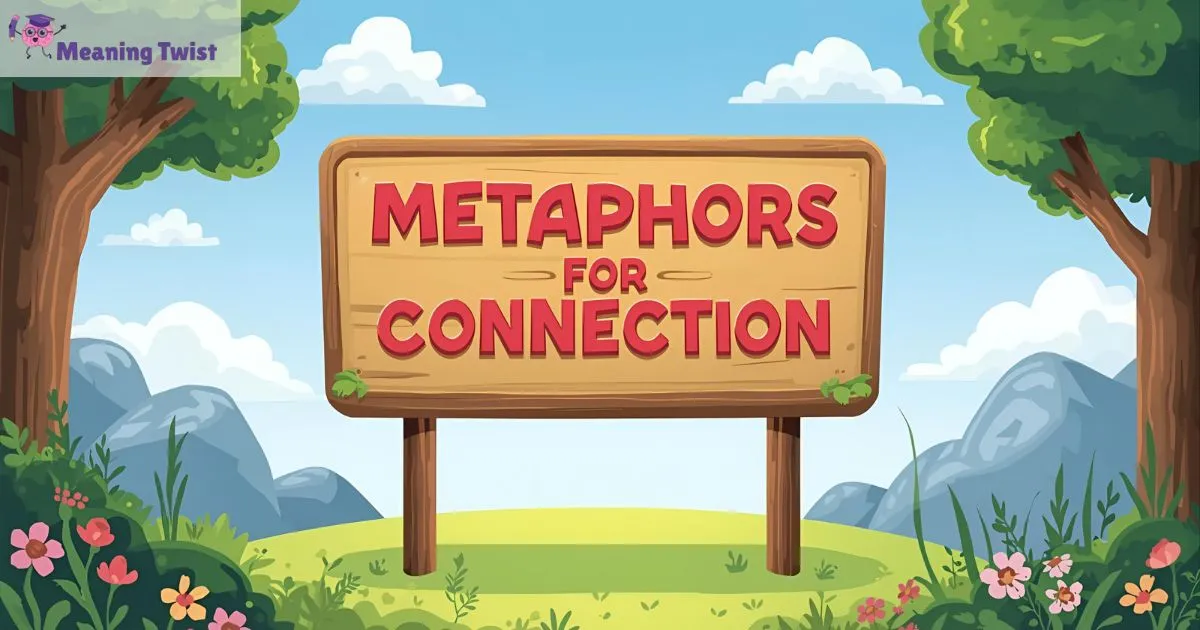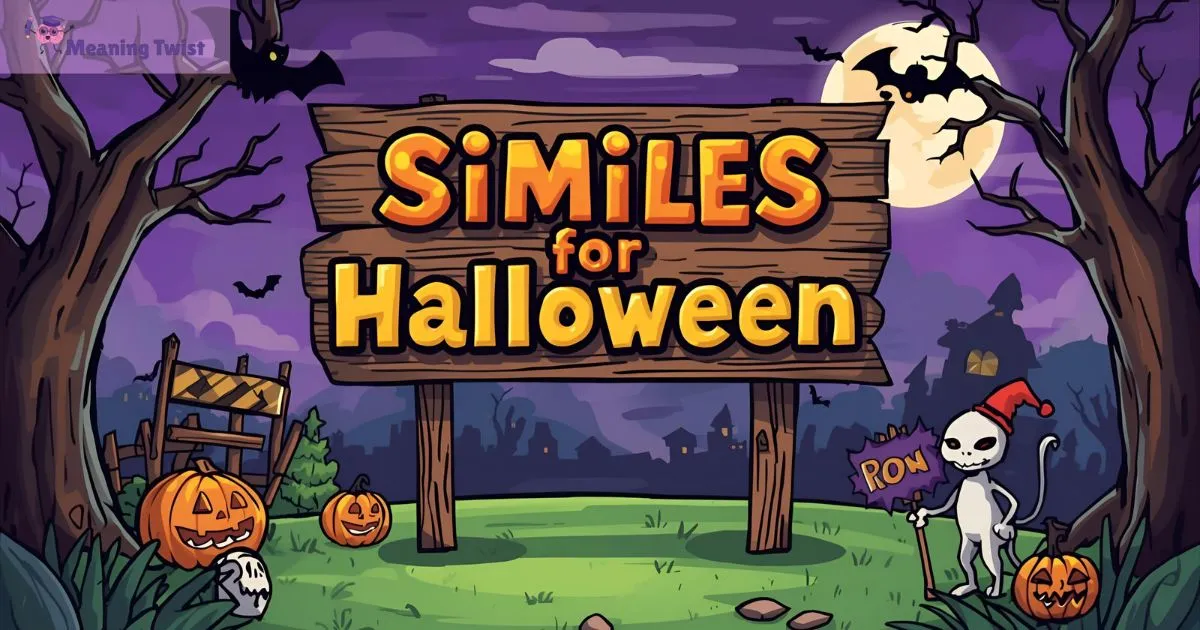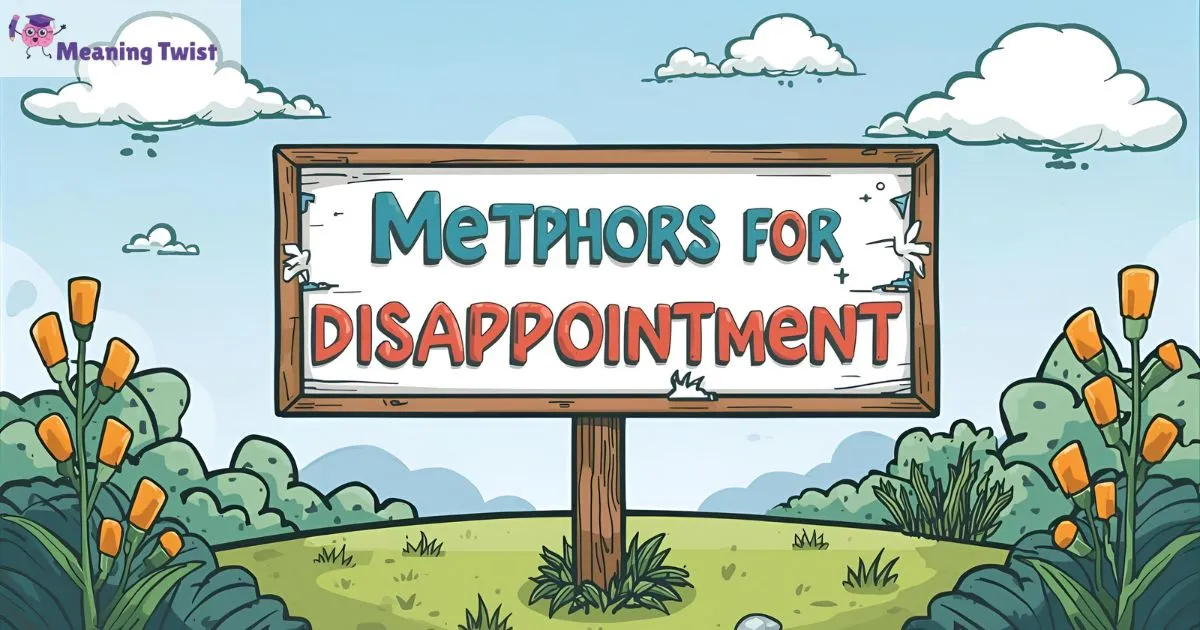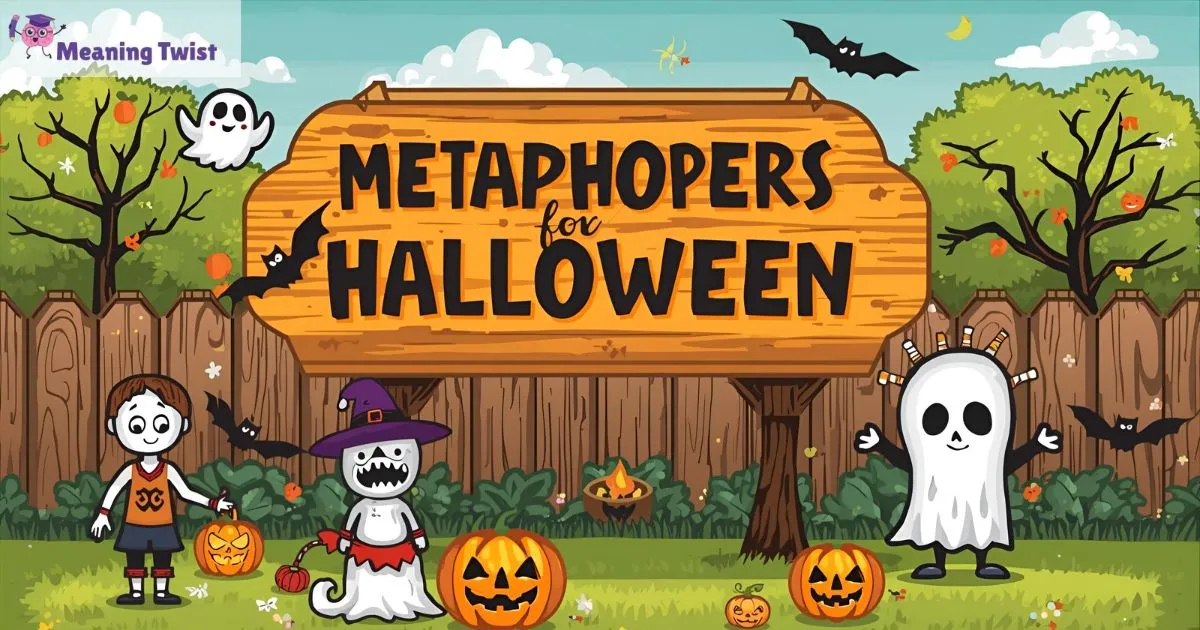
Metaphors for Halloween are a spooky, fun way to describe feelings, situations, or ideas without saying them directly. A metaphor is when we compare one thing to another to make our language more colorful like turning ordinary words into magic! Using metaphors helps us express emotions, moods, or situations creatively, giving our stories and conversations a playful, vivid twist.
For example, saying “Her laugh was a bubbling cauldron of mischief” uses a Halloween-themed metaphor. It doesn’t just mean she laughed, it shows she’s full of mischievous energy, just like a witch’s potion brewing in a cauldron.
Metaphors can come from food, love, advice, or even animals, letting you share hungry feelings, heartfelt language, wise words, or wild emotions in clever, expressive ways.
Get ready to explore and master metaphors for Halloween, making your writing and speech as enchanting and fun as a haunted house adventure!
Best Metaphors for Halloween
1. Spooky Night Imagery Explained
Meaning:
This metaphor describes a night that feels eerie, mysterious, or full of suspense, like shadows moving and strange sounds around you.
When to Use It:
Use it when you want to create a Halloween mood, describe suspense in stories, or make your reader feel a little shiver of excitement.
In a Sentence:
- I tiptoed through the yard, and the spooky night imagery made every tree look like it was whispering secrets.
- He felt the spooky night imagery as the wind howled around the old house.
Other Ways to Say:
- eerie night
- ghostly evening
- mysterious darkness
- haunted shadows
Fun Tip or Visual Clue:
Imagine a moonlit backyard with long, twisting shadows and the distant hoot of an owl. That’s your visual cue for this metaphor!
2. Ghostly Shadows of Halloween
Meaning:
This metaphor paints a picture of shadows that seem alive, floating, or whispering, giving a haunted and magical feeling.
When to Use It:
Perfect for describing creepy settings, Halloween stories, or times when something mysterious catches your eye.
In a Sentence:
- I watched the ghostly shadows of Halloween dance across the walls as the candle flickered.
- She noticed the ghostly shadows of Halloween stretching along the empty hallway.
Other Ways to Say:
- phantom silhouettes
- haunted shadows
- spectral shapes
- eerie figures
Fun Tip or Visual Clue:
Picture a flickering candle casting long, moving shapes that look like tiny spirits. That helps you “see” the metaphor.
3. Creepy Vibes in Literature
Meaning:
This metaphor refers to the feeling of suspense, eeriness, or spookiness a story gives you.
When to Use It:
Use it when writing stories, poems, or descriptions that need a Halloween or suspenseful atmosphere.
In a Sentence:
- I felt the creepy vibes in literature when the old mansion’s doors creaked open.
- They sensed the creepy vibes in literature as the character wandered through the foggy forest.
Other Ways to Say:
- eerie mood
- spooky atmosphere
- chilling feeling
- haunting aura
Fun Tip or Visual Clue:
Think of the page turning slowly in a dimly lit room while the wind rattles the window. That’s the “vibe” of this metaphor!
4. Halloween’s Eerie Atmosphere Guide
Meaning:
This metaphor describes the overall spooky, unsettling feeling that Halloween brings, full of shadows, chills, and mysterious sounds.
When to Use It:
Use it to set the mood in stories, poems, or descriptions of Halloween parties and haunted settings.
In a Sentence:
- I felt Halloween’s eerie atmosphere as I walked past the foggy cemetery.
- She noticed Halloween’s eerie atmosphere in the quiet streets filled with jack-o’-lanterns.
Other Ways to Say:
- spooky mood
- haunted ambiance
- chilling surroundings
- mysterious aura
Fun Tip or Visual Clue:
Imagine flickering lights, rustling leaves, and distant laughter. Your senses instantly “see” the Halloween vibe.
5. Monsters as Symbolic Figures
Meaning:
This metaphor uses monsters to represent fears, challenges, or emotions that feel larger than life.
When to Use It:
Perfect for describing personal fears, obstacles, or scary stories in a creative way.
In a Sentence:
- I faced the monsters as symbolic figures of my worries in the dark hallway.
- He saw the monsters as symbolic figures lurking in his imagination.
Other Ways to Say:
- fearsome creatures
- imagined beasts
- symbolic nightmares
- scary figures
Fun Tip or Visual Clue:
Picture a cartoon monster hiding behind a door, representing a small worry it helps you link the metaphor to feelings.
6. Haunted Houses and Metaphors
Meaning:
This metaphor compares houses or places to haunted spaces, showing fear, mystery, or secrets inside.
When to Use It:
Use it when describing mysterious locations or situations in writing or storytelling.
In a Sentence:
- I tiptoed inside the haunted houses and metaphors, feeling secrets in every room.
- She imagined haunted houses and metaphors hiding stories behind every creaky door.
Other Ways to Say:
- ghostly homes
- mysterious buildings
- spooky houses
- haunted spaces
Fun Tip or Visual Clue:
Think of a dimly lit house with shadows stretching across the walls; it instantly gives the metaphor meaning.
7. Pumpkin Nights and Darkness
Meaning:
This metaphor describes the mix of warm lights and deep shadows during Halloween nights, symbolizing contrasts of safety and spookiness.
When to Use It:
Use it for setting scenes, writing descriptive passages, or capturing Halloween’s magical mood.
In a Sentence:
- I wandered through pumpkin nights and darkness, feeling the glow of lanterns and the chill of shadows.
- They enjoyed pumpkin nights and darkness as jack-o’-lanterns flickered on every porch.
Other Ways to Say:
- glowing nights
- shadowy evenings
- lantern-lit darkness
- spooky pumpkin glow
Fun Tip or Visual Clue:
Picture glowing pumpkins casting long shadows on the ground, a perfect visual for this metaphor.
Read More: Metaphors for Hatred That Capture Intense Darkness
8. Witches as Hidden Symbols
Meaning:
This metaphor uses witches to represent hidden powers, secrets, or cleverness in stories or life situations.
When to Use It:
Use it in writing or lessons to show clever tricks, unseen talents, or mysterious knowledge.
In a Sentence:
- I noticed witches as hidden symbols in the story, showing cleverness behind every spell.
- He realized witches as hidden symbols represented secrets he had yet to uncover.
Other Ways to Say:
- magical figures
- mysterious women
- cunning characters
- symbolic spellcasters
Fun Tip or Visual Clue:
Imagine a witch stirring a cauldron filled with glowing ideas each spell has a hidden meaning.
9. Autumn Fear in Writing
Meaning:
This metaphor uses the fall season to show anxiety, suspense, or change, combining falling leaves with eerie moods.
When to Use It:
Use it when describing changing times, tension, or spooky fall scenes in stories.
In a Sentence:
- I felt autumn fear in writing as leaves rustled like whispers in the dark.
- She sensed autumn fear in writing while walking through the foggy park.
Other Ways to Say:
- fall suspense
- seasonal chills
- autumn eeriness
- harvest-time tension
Fun Tip or Visual Clue:
Picture crisp leaves blowing in the wind, each rustle a little spookyperfect for imagining the metaphor.
10. Shadows Dancing on Walls
Meaning:
This metaphor describes shadows moving in a lively or mysterious way, creating a spooky or magical feeling.
When to Use It:
Use it to add visual drama or suspense to Halloween scenes or imaginative stories.
In a Sentence:
- I watched shadows dancing on walls as the candlelight flickered.
- They noticed shadows dancing on walls, making the room feel alive and mysterious.
Other Ways to Say:
- flickering silhouettes
- moving shadows
- ghostly shapes
- animated darkness
Fun Tip or Visual Clue:
Think of a small flashlight casting long, wiggly shapes on the wall instantly “see” the metaphor.
11. Vampires as Fear Metaphors
Meaning:
This metaphor uses vampires to symbolize hidden dangers, fears, or draining experiences in stories or life.
When to Use It:
Use it when describing something that seems harmless but can take away energy or security.
In a Sentence:
- I imagined vampires as fear metaphors lurking in the corners of the haunted castle.
- She realized vampires as fear metaphors represented worries that drained her confidence.
Other Ways to Say:
- bloodsucking fears
- lurking dangers
- shadowy threats
- sinister figures
Fun Tip or Visual Clue:
Picture a vampire hiding behind a curtainits presence hints at fear without showing it directly.
12. Trick-or-Treat Night Imagery
Meaning:
This metaphor captures the playful and spooky energy of Halloween night, with kids in costumes, candies, and excitement.
When to Use It:
Use it in stories, poems, or descriptions of Halloween celebrations or childhood adventures.
In a Sentence:
- I enjoyed trick-or-treat night imagery as kids ran from door to door laughing.
- They felt trick-or-treat night imagery with every candy-filled bag and glowing jack-o’-lantern.
Other Ways to Say:
- costume night fun
- Halloween adventure
- candy-filled evening
- spooky celebration
Fun Tip or Visual Clue:
Picture small ghosts and witches running around the neighborhood, bags in handa perfect visual.
13. Horror in Everyday Life
Meaning:
This metaphor describes scary or unsettling feelings in normal situations, making ordinary moments feel eerie.
When to Use It:
Use it to add suspense or creativity to stories, reflections, or dramatic writing.
In a Sentence:
- I saw horror in everyday life when the lights flickered during the storm.
- She sensed horror in everyday life while walking through the empty, quiet streets.
Other Ways to Say:
- spooky moments
- eerie situations
- everyday scares
- chilling experiences
Fun Tip or Visual Clue:
Think of a regular street turning mysterious at night and becoming spooky.
14. Dark Forests as Symbols
Meaning:
This metaphor uses forests to symbolize mystery, danger, or the unknown, especially in stories or scary settings.
When to Use It:
Use it when describing challenges, fears, or adventures in writing or imagination.
In a Sentence:
- I wandered through dark forests as symbols, feeling the unknown around every tree.
- They saw dark forests as symbols hiding secrets in the mist.
Other Ways to Say:
- shadowy woods
- mysterious forests
- haunted groves
- hidden wilderness
Fun Tip or Visual Clue:
Picture thick trees blocking sunlight, with a narrow path your mind instantly “reads” mystery and suspense.
15. Spirits and Hidden Meanings
Meaning:
This metaphor uses spirits to represent unseen ideas, feelings, or messages, often mysterious or secret.
When to Use It:
Use it to describe hidden emotions, mysterious thoughts, or subtle hints in stories and poems.
In a Sentence:
- I felt spirits and hidden meanings in the whispers of the old attic.
- She noticed spirits and hidden meanings behind every creaking floorboard.
Other Ways to Say:
- ghostly hints
- unseen messages
- secret energies
- mysterious forces
Fun Tip or Visual Clue:
Imagine faint shapes floating in a roomeach spirit “carrying” a secret idea.
16. Candles Casting Ghostly Light
Meaning:
This metaphor describes the way candlelight creates moving shadows and eerie moods, making spaces feel magical or spooky.
When to Use It:
Use it in descriptive writing, spooky scenes, or Halloween storytelling.
In a Sentence:
- I watched candles casting ghostly light as the shadows flickered on the walls.
- They enjoyed candles casting ghostly light during the storytelling night.
Other Ways to Say:
- flickering lanterns
- glowing candle shadows
- spectral lights
- eerie illumination
Fun Tip or Visual Clue:
Picture a candle flame dancing in the dark, making walls look alive, perfect for imagination.
17. Moonlit Night Metaphors
Meaning:
This metaphor uses moonlight to symbolize mystery, calm, or magical eeriness at night.
When to Use It:
Use it to set a quiet, mysterious, or slightly spooky mood in stories or poems.
In a Sentence:
- I walked through the garden under moonlit night metaphors, feeling calm and curious.
- He noticed moonlit night metaphors as shadows stretched long across the yard.
Other Ways to Say:
- glowing moonlight
- silver-lit nights
- mystical evenings
- lunar shadows
Fun Tip or Visual Clue:
Imagine the moon casting soft, silver light; everything looks mysterious yet magical.
Read More: Metaphors for Hunger That Sparak Emotion and Creativity
18. Halloween Costumes as Symbols
Meaning:
This metaphor treats costumes as representations of personality, feelings, or imagination.
When to Use It:
Use it when showing creativity, hidden traits, or playful expressions in stories or lessons.
In a Sentence:
- I chose a wizard costume, showing Halloween costumes as symbols of my imagination.
- She realized Halloween costumes as symbols expressed her love for adventure.
Other Ways to Say:
- symbolic outfits
- creative disguises
- expressive costumes
- character representations
Fun Tip or Visual Clue:
Think of every mask or costume as a little story revealing the wearer’s inner world.
19. Frightening Metaphors for Kids
Meaning:
This metaphor describes scary ideas or feelings in a way children can understand, often playful or spooky.
When to Use It:
Use it in stories, lessons, or Halloween activities to show fear safely and imaginatively.
In a Sentence:
- I read frightening metaphors for kids about ghosts hiding under beds.
- They laughed at frightening metaphors for kids when witches popped out in the story.
Other Ways to Say:
- spooky imagery
- playful scares
- child-friendly horror
- eerie fun
Fun Tip or Visual Clue:
Imagine a friendly ghost or silly monster scary but not too real!
20. Fear Hidden in Shadows
Meaning:
This metaphor shows fear lurking unseen, often creating suspense or tension.
When to Use It:
Use it in writing spooky scenes, describing anxiety, or building suspense.
In a Sentence:
- I felt fear hidden in the shadows as I walked down the empty hallway.
- She noticed fear hidden in shadows behind the old barn doors.
Other Ways to Say:
- lurking fright
- shadowed terror
- hidden dread
- eerie darkness
Fun Tip or Visual Clue:
Picture shapes hiding in corners, your imagination fills in the fear.
21. Creepy Sounds as Imagery
Meaning:
This metaphor uses sounds like creaks, howls, or whispers to create a spooky or suspenseful mood.
When to Use It:
Use it in descriptive writing, storytelling, or poetry to make scenes more vivid.
In a Sentence:
- I listened to creepy sounds as imagery while walking through the attic.
- He imagined creepy sounds as imagery echoing down the hallway.
Other Ways to Say:
- eerie noises
- haunted sounds
- spine-chilling echoes
- ghostly whispers
Fun Tip or Visual Clue:
Think of wind rattling a window or distant footsteps sounds that can tell a story on their own.
22. Black Cats and Symbolism
Meaning:
This metaphor uses black cats to symbolize mystery, bad luck, or hidden secrets in stories or traditions.
When to Use It:
Use it when describing suspense, superstition, or Halloween imagery.
In a Sentence:
- I saw a black cat and symbolism crossing the path, making the story feel mysterious.
- She noticed black cats and symbolism hiding in the shadows of the garden.
Other Ways to Say:
- mysterious felines
- spooky cats
- symbolic animals
- omen creatures
Fun Tip or Visual Clue:
Picture a sleek black cat silently walking by your mind immediately senses mystery.
23. Haunted Paths in Stories
Meaning:
This metaphor describes paths or journeys as full of danger, mystery, or hidden surprises.
When to Use It:
Use it in stories, lessons, or descriptions of adventures that include suspense.
In a Sentence:
- I followed haunted paths in stories, unsure what I would find around the corner.
- They explored haunted paths in stories, feeling thrill and fear at every turn.
Other Ways to Say:
- ghostly trails
- spooky routes
- mysterious walks
- eerie journeys
Fun Tip or Visual Clue:
Imagine a twisting path through foggy woods every step could hide something unexpected.
24. Foggy Nights Represent Fear
Meaning:
This metaphor uses fog to show uncertainty, fear, or suspense, making scenes mysterious.
When to Use It:
Use it in writing suspenseful, eerie, or dramatic scenes.
In a Sentence:
- I walked through foggy nights representing fear, each shadow seeming alive.
- She sensed foggy nights representing fear while crossing the empty park.
Other Ways to Say:
- misty dread
- hazy tension
- shadowy uncertainty
- chilling fog
Fun Tip or Visual Clue:
Picture mist swirling around streetlights, hiding what’s ahead perfect for building suspense.
25. Spells and Literary Meaning
Meaning:
This metaphor uses spells to symbolize influence, change, or hidden power in stories and writing.
When to Use It:
Use it when describing magic, transformation, or secret effects in literature or storytelling.
In a Sentence:
- I imagined spells and literary meaning transforming the ordinary into the extraordinary.
- They noticed spells and literary meaning shaping the events in the story magically.
Other Ways to Say:
- magical influence
- enchanting effects
- transformative power
- mystical impact
Fun Tip or Visual Clue:
Picture a wand waving, changing the scene every spell tells a story beyond the obvious.
26. Terror in Small Details
Meaning:
This metaphor focuses on tiny, often overlooked things that create fear or suspense, like a creaking floorboard or a flickering light.
When to Use It:
Use it in stories or poems to build tension and make ordinary scenes feel spooky.
In a Sentence:
- I noticed terror in small details when the doorknob rattled all by itself.
- She felt terror in small details as shadows moved across the wall.
Other Ways to Say:
- subtle scares
- hidden frights
- tiny eerie moments
- minor creepy signs
Fun Tip or Visual Clue:
Imagine focusing on a single, shaking candle flamesmall details can feel scary!
27. Chilling Autumn Symbolism
Meaning:
This metaphor uses fall imagery like bare trees, wind, and fallen leaves to show fear, change, or eeriness.
When to Use It:
Use it in descriptions of Halloween, seasonal stories, or suspenseful writing.
In a Sentence:
- I felt chilling autumn symbolism as the wind rustled the dead leaves.
- He noticed chilling autumn symbolism in the bare trees against the gray sky.
Other Ways to Say:
- fall eeriness
- autumn suspense
- seasonal chills
- harvest-time mystery
Fun Tip or Visual Clue:
Picture a foggy path lined with naked trees. The season itself sets the mood.
28. Halloween Magic and Mystery
Meaning:
This metaphor uses magic and mysterious elements to show wonder, surprise, or the unknown during Halloween.
When to Use It:
Use it when writing about enchanted moments, surprises, or magical Halloween settings.
In a Sentence:
- I felt Halloween magic and mystery as the lanterns flickered in the dark.
- She noticed Halloween magic and mystery when the fog rolled in silently.
Other Ways to Say:
- spooky enchantment
- mystical Halloween
- magical eeriness
- mysterious vibes
Fun Tip or Visual Clue:
Picture floating lights or sparkling dust in the airmagic is all around!
29. Candies with Dark Meaning
Meaning:
This metaphor turns Halloween treats into symbols of temptation, surprise, or hidden messages.
When to Use It:
Use it in stories, poems, or lessons to show that something sweet can hide mystery or caution.
In a Sentence:
- I imagined candies with dark meaning that whispered secrets with every bite.
- They noticed candies with dark meaning hiding in shadowy corners of the party.
Other Ways to Say:
- hidden treats
- mysterious sweets
- symbolic candies
- spooky snacks
Fun Tip or Visual Clue:
Picture a candy glowing strangely in the dark it looks sweet but hints at mystery.
30. Ghost Stories and Symbols
Meaning:
This metaphor uses ghosts to represent memories, fears, or past events in stories.
When to Use It:
Use it to add depth, suspense, or hidden meaning to spooky tales or lessons.
In a Sentence:
- I listened to ghost stories and symbols that reminded me of old mysteries.
- She read ghost stories and symbols and felt shivers with every tale.
Other Ways to Say:
- haunted tales
- spectral narratives
- spooky legends
- phantom stories
Fun Tip or Visual Clue:
Imagine a faint ghostly figure in a storybook each ghost carries a hidden meaning.
31. Pumpkins as Night Imagery
Meaning:
This metaphor uses pumpkins glowing at night to symbolize warmth, mystery, or Halloween spirit.
When to Use It:
Use it in descriptions, storytelling, or scene-setting during Halloween.
In a Sentence:
- I saw pumpkins as night imagery lighting up the dark street.
- They noticed pumpkins as night imagery glowing mysteriously on every porch.
Other Ways to Say:
- glowing jack-o’-lanterns
- lantern pumpkins
- night lights
- Halloween glow
Fun Tip or Visual Clue:
Picture carved pumpkins with flickering candles inside each one adds mood and story.
32. Horror Themes in Writing
Meaning:
This metaphor highlights scary, suspenseful, or dark ideas used in stories, poems, or lessons.
When to Use It:
Use it when discussing writing, literature, or storytelling to create fear or tension.
In a Sentence:
- I explored horror themes in writing to make my story thrilling.
- She enjoyed horror themes in writing while reading spooky tales at night.
Other Ways to Say:
- scary motifs
- suspenseful elements
- dark storylines
- chilling ideas
Fun Tip or Visual Clue:
Think of each story element as a tool to make your readers shiver. Horror is crafted, not just found.
33. Halloween’s Symbolic Darkness
Meaning:
This metaphor uses darkness to represent fear, mystery, and the unknown during Halloween.
When to Use It:
Use it when describing spooky settings, tension, or dramatic contrasts in stories.
In a Sentence:
- I felt Halloween’s symbolic darkness as shadows stretched across the empty street.
- They noticed Halloween’s symbolic darkness hiding secrets behind every corner.
Other Ways to Say:
- eerie darkness
- haunted shadows
- spooky night
- mysterious gloom
Fun Tip or Visual Clue:
Picture long shadows stretching under moonlight; the darkness itself tells a story.
Practice Exercise: Metaphors for Halloween
Sentences
- Last night, walking through the backyard made me feel like I was in a _________.
- When I saw the long, moving shapes on the wall, I imagined _________ everywhere.
- The book gave me strange, scary feelings while reading; it was full of _________.
- The decorations in our classroom really set _________ for Halloween.
- My little brother dressed as big, scary creatures to show _________ in the story we wrote.
- The old, creaky house at the end of the street looked like one of those _________.
- On Halloween, the glowing pumpkins in the yard reminded me of _________.
- The story about a clever witch taught me to think about _________ in hidden ways.
- Reading about leaves falling and shadows made me notice _________ in autumn.
- When the lights flickered and shadows stretched across the wall, I could see _________.
- The story about a vampire in the castle helped us understand _________ in books.
- Walking door-to-door for candy gave me exciting memories of _________.
- Forgetting my homework sometimes makes me feel like there is _________ in daily life.
- Hiking in the misty woods at night reminded me of _________ waiting for me in stories.
Answer Key
- Spooky Night Imagery Explained
- Ghostly Shadows of Halloween
- Creepy Vibes in Literature
- Halloween’s Eerie Atmosphere Guide
- Monsters as Symbolic Figures
- Haunted Houses and Metaphors
- Pumpkin Nights and Darkness
- Witches as Hidden Symbols
- Autumn Fear in Writing
- Shadows Dancing on Walls
- Vampires as Fear Metaphors
- Trick-or-Treat Night Imagery
- Horror in Everyday Life
- Dark Forests as Symbols
How to Use Metaphors for Halloween in Everyday Conversations
Using metaphors for Halloween in everyday conversations lets you add spooky flair, imaginative comparisons, and creativity to how you describe feelings, situations, or events. By comparing everyday moments to ghostly shadows, haunted houses, or pumpkin-lit nights, you make your speech more vivid and memorable.
If talking about a mysterious surprise, a funny scare, or autumn vibes, these metaphors bring Halloween magic, creepy imagery, and playful seasonal expressions into daily life, making your language both engaging and imaginative.
Final Words
You’re not alone if you’ve ever felt nervous, excited, or a little spooky and didn’t know how to explain it. Metaphors for Halloween make tricky emotions easier to talk about, helping you share your feelings at school, home, or with friends in a fun, creative way.
By comparing moods to haunted houses, glowing pumpkins, or ghostly shadows, you turn ordinary moments into vivid stories. Next time you’re feeling this way, you’ll know exactly what to say! Keep exploring metaphors and using them confidently in your speaking and writing. It makes expressing yourself magical and memorable.

Hi, I am Joey, the admin of meaningtwist.com. I simplify deep meanings and twist ordinary words into extraordinary insights to spark your curiosity and clicks!

